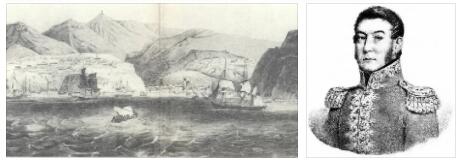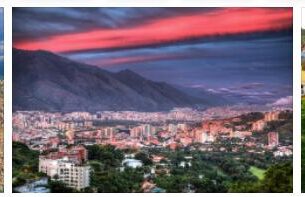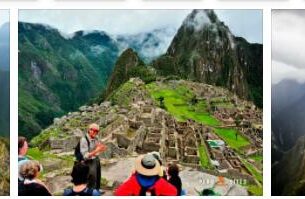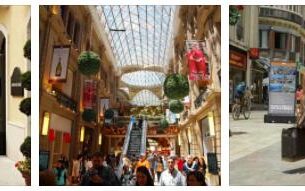In 1535, Spanish conquerors led by Diego de Almagro invaded Chile. Due to the fierce resistance of the Indians, the Spaniards did not advance further than the Maule River. Later, Pedro de Valdivia undertook a more successful expedition, and on February 12, 1541, he laid the first city in the present territory of Chile – Santiago. July 14, 1810 began the war for the independence of Chile from the Spanish crown. On September 18, 1810, the National Government Junta was established. The Chileans, under the banner of Bernardo O’Higgins, defeated the Spanish army at the Battle of Chacabuco (1817). The independence of Chile was proclaimed on February 12, 1818. The first Constitution of Chile was adopted in 1833 with the participation of Diego Portales, leader of the moderate wing of the conservatives. Favorable conditions for the further development of the country were created by Chile’s victory in the Pacific War of 1879–83 against Peru and Bolivia. The northern regions rich in saltpeter deposits came under Chile’s control. Check diseaseslearning for political system of Chile.
Attempts at deep reforms were made by H.M. Balmaceda. His attempt to nationalize the saltpeter industry, which was in the hands of British companies, caused a sharp rebuff from the conservative opposition. In January 1891 rebels from the saltpeter northern provinces entered the capital. Balmaceda shot himself. The reign of Arturo Alessandri (1920–25) saw the restoration of strong presidential power. The new Constitution adopted in 1925 endowed the president with almost unlimited powers. However, real power in the country was concentrated in the hands of Minister of War C. Ibáñez, who established a personal dictatorship in 1927 (1927–31). Democratic organizations were banned in the country, the saltpeter industry was placed under the control of the United States.
In 1932, as a result of a coup d’état, a group of officers proclaimed Chile a socialist republic. A Provisional Junta was created, councils of workers’ deputies were formed, the central bank was nationalized, and Americans’ privileges in the saltpeter industry were abolished. However, the socialist republic lasted only 12 days. The dictatorship of Colonel K. Davila was established in the country. But already in September 1932, as a result of a new military coup, the dictatorship, which had existed for 100 days, was overthrown. Arturo Alessandri won the election. The situation in the country has stabilized.
During the second reign of A. Alessandri (1932-38), the government’s predilections were manifested in the development of ties with Germany. In contrast, in Chile, the Popular Front was created in 1936, which included the radical, socialist, and communist parties. Trade union organizations of the country united in the Confederation of Workers of Chile, which joined the Popular Front. Popular Front candidate Pedro Aguirre Cerda won the 1938 presidential election. His government (1938–41) expanded democratic freedoms and took measures against pro-fascist groups. Of particular importance was the creation in 1939 of the Production Development Corporation (CORFO), which led to the formation of the state sector of the economy. After the death of Aguirre Cerda in 1941, J. Rios (1942–46), a candidate from the broad coalition of the Democratic Alliance, won the presidency.
The Rios government hesitated to join the anti-fascist coalition, seeking to use the benefits of neutrality (Chile declared war on the Axis powers only in February 1945). In the presidential elections of 1946, the candidate from the Democratic Alliance, the radical R. Gonzalez Videla, won. His reign (1946–52) was characterized by the inclusion of representatives of left-wing parties in the government. The appearance of three ministers from the Communist Party caused concern for the centrists and the right. As a result, Videla eliminated the Communists from the government and on October 21, 1947 announced the severance of diplomatic relations with the USSR (which were established at the beginning of his reign).
In 1952–58 the presidency was again taken by C. Ibáñez, whose rule bore national-reformist features. In 1953, at a congress of Chilean trade unions, the United Workers’ Center (UTC) was created, which united the vast majority of workers and employees.
In 1958 Jorge Alessandri, a representative of industrial and financial circles, became president of Chile. He was replaced in 1964 by the Christian Democrat Eduardo Frei Montalva, who countered the line of the radical left revolutionaries with the slogan “Revolution in freedom.” In 1964 diplomatic relations with the USSR were restored.
The hopes of a significant part of the country’s citizens for a quick solution to cardinal problems contributed to the victory in the elections on September 4, 1970 of the candidate from the bloc of communists, socialists and other leftist forces of the Popular Unity of Salvador Allende. His government (1970–73) proclaimed as its goal the creation of the prerequisites for building a socialist society. The main natural resources, most banks, and key industries were nationalized. However, the aggravated internal problems, the unwinding spiral of hyperinflation, the shortage of essential goods, the opposition of large owners led to the sharpest opposition of social forces.
Under these conditions, on September 11, 1973, the army elite under the leadership of General A. Pinochet carried out a coup d’état, during which President S. Allende died. The military-dictatorial regime (1973–90) abolished the existing legislation and banned the activities of political parties. In 1980, a new Constitution was adopted in Chile, which significantly strengthened the powers of the executive branch. In a referendum on October 5, 1988, the majority of Chileans voted for the restoration of democracy. On December 14, 1989, the first presidential elections were held after a long break. The victory was won by the candidate of the United Parties for Democracy, Christian Democrat Patricio Aylvin (1989-93). He was replaced by candidates from the same bloc, first the Christian Democrat Eduardo Frei Ruiz-Tagle (1993–99) and then the socialist Ricardo Lagos (since 2000).



